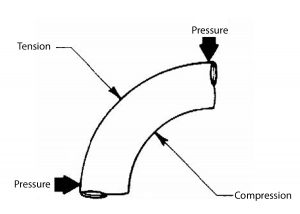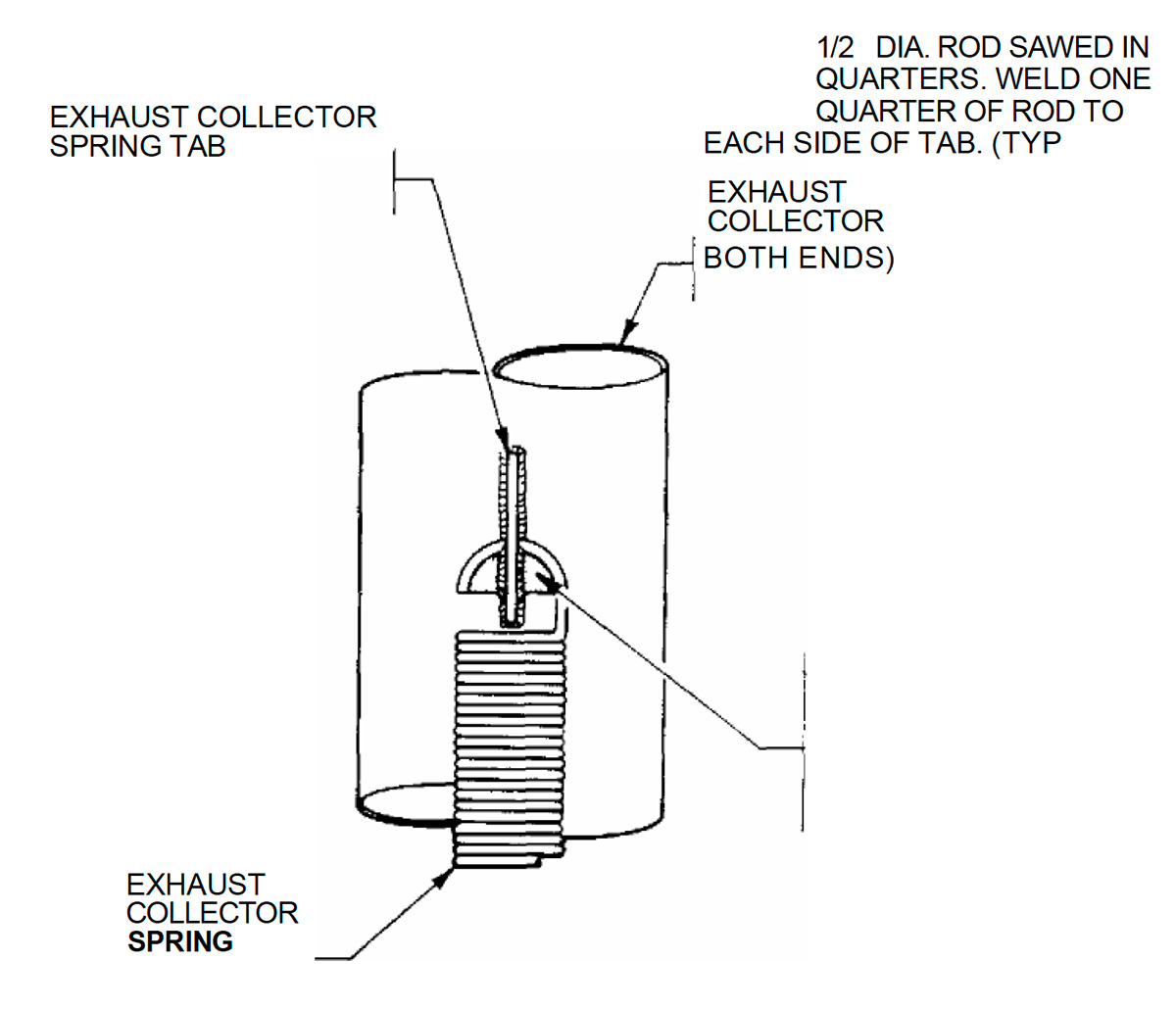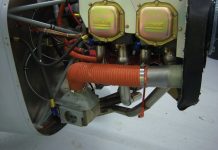Noise
 Noise, as it pertains to our discussion here, is simply unwanted sound. Many people are bothered and angered by aircraft noise. Although in metropolitan areas jet traffic is probably the chief culprit, light airplanes are also the subject of many complaints. We, as pilots, can surely tolerate and even welcome the sound of aircraft flying around—especially our own. But to the average non-aviation person, this can be a serious infringement to their outdoor peace. It’s a sensitive issue. The FAA and the EPA have developed regulatory standards to help curb the audible attack on our open-air environment. Although amateur built aircraft are excluded from these regulations, they provide excellent guidelines and standards.
Noise, as it pertains to our discussion here, is simply unwanted sound. Many people are bothered and angered by aircraft noise. Although in metropolitan areas jet traffic is probably the chief culprit, light airplanes are also the subject of many complaints. We, as pilots, can surely tolerate and even welcome the sound of aircraft flying around—especially our own. But to the average non-aviation person, this can be a serious infringement to their outdoor peace. It’s a sensitive issue. The FAA and the EPA have developed regulatory standards to help curb the audible attack on our open-air environment. Although amateur built aircraft are excluded from these regulations, they provide excellent guidelines and standards.
High levels of sound a long distance away can be annoying. But at close range it can be harmful. The hearing of many pilots has deteriorated because of prolonged exposure to noise above normal levels. Personnel in the U.S. Air Force are required to wear ear protectors for any sound above 85 decibels. To give an idea of the levels of sound for comparison, here are some examples:
| Jet plane departing | 150 (dB) |
| Threshold of pain | 140 |
| Airport terminal boarding ramp | 120 |
| HiFi played by average teenager | 110 |
| Light aircraft, outboard motor | 105 |
| Busy street corner | 95 |
| Compact automobile interior | 85 |
| Dividing point between safe and unsafe sound range | 80 |
| Business office, workshop | 70 |
| Normal conversation | 60 |
| Refrigerator | 40 |
| Whispering | 30 |
| Normal breathing | 10 |
Even though the Glasair has been designed as a high performance airplane, most builders would agree it is desirable to have the plane as quiet as reasonably possible. Some are even considering a custom-fit muffler installation, as our standard exhaust systems emphasize horsepower rather than external sound muffling. A bigger concern, however, is the interior sound level of the airplane. A quiet cockpit is a desirable item for comfort. Just as a point of interest, here are the average interior sound levels of our 2 factory prototypes, N895H and N875H with actual readings taken under several different conditions. It should be noted that these airplanes lack a fabric covered interior. No special attempts at sound-deadening have been made.
| Taxi | 85 (dB) |
| Run-up | 93 |
| Climb out | 100 |
| Power off Glide 200mph | 100 |
| Power off Glide 135 mph | 100 |
| Cruise (75%) | 88 |
| Stall | 85 |
Our experience has shown that placing some type of fabric wherever possible in the interior is a key in achieving a quiet airplane. For maximum sound insulation several other areas should be taken care of. A full-size baggage bulkhead greatly lowers the noise level by sealing off the rear fuselage and empennage. The firewall should be insulated with some effective sound deadening material. Also, the canopies should be sealed well to eliminate much of the wind noise. We are planning to install fabric interiors on our prototype planes. We will inform you of the dB changes in the next newsletter.
Besides quieting down the engine, an exhaust system is designed to carry heat and exhaust gases away from the engine without burning up the airplane or exposing the pilot to harmful and unpleasant fumes. The FAA regulations require exhaust systems to be made of fire-resistant materials, an assembly that allows for expansion due to temperature changes, and proper supporting to accommodate vibration and inertia loads. Once again these rules do not govern experimentals, but nonetheless are very essential rules to follow.
Types of Exhausts
There are several common types of exhausts, including mufflers, short stacks, manifolds, and cross-overs.
The use of a muffler has traditionally been the most common way of reducing the noise of engine exhaust. Rapidly expanding, turbulent air exiting the engine is the source of all the noise. A muffler provides a large chamber in which these sounds are reduced. Generally, the larger the muffler and the longer the downstream pipe, the quieter the engine. Unfortunately, this combination often creates a large amount of back pressure, thereby reducing engine power output. Back pressure, of course, is a condition in which the exhaust gases are not expelled completely outside the airplane as quickly as they are expelled from the engine exhaust ports. Excessive back pressure translates into a loss of horsepower and economy. Installing a muffler in a homebuilt plane is a trade-off between a quiet engine and a loss of power and performance due to resistance and back pressure.
Another disadvantage of a muffler is its size. Taking up a lot of room in the lower engine compartment, it will sometimes exclude the adaptation of a very tight fitting lower cowl. In recent years the aviation world has seen the development of a few newer muffler designs that incorporate long tail pipes. Some of these have proved extremely effective, including the Swiss muffler.
“Short stacks” are seldom used except on formula racers and other high performance planes. These pipes are bolted right to the exhaust ports and usually are routed directly to the outside of the cowling. They are very light, efficient, and produce no significant back pressure. However, they are very loud. They leave little room for the use of heat muffs. Because of their location, exhaust fumes can sometimes enter the cockpit. Short stacks can also allow a large drop of temperature at the exhaust ports (thermal shock) when power is suddenly reduced.
A manifold system is one which joins the exhaust pipes on one side of the engine. (Each side will have a manifold.) Airplanes that have two tailpipes exiting the lower rear cowl are often using this arrangement. In some airplanes the manifold from each side is interconnected and a single tailpipe is used.
The system that is sold and used for the Glasair is one example of a cross-over exhaust. A cross-over system ports the cylinders in their correct firing order, minimizing back pressure by uniformly spacing the exhaust pulses. To accomplish this, the front cylinder ports are joined together by a single pipe, as are the rear. Standard unmuffled cross-over systems usually exit with two pipes the same size as those that exit the ports on the cylinders (1 3/4″). This arrangement is very loud. By funneling the pipes into a one-piece 2-1/2 ” collector, the noise is reduced. We tested both arrangements on the Glasair.
Material
In today’s airplanes there are basically two kinds of material being used for exhausts. Automotive or “mild steel” pipes are very economical when properly protected against corrosion. They should be painted with a very high temperature paint, and then inspected regularly and touched up when necessary. Under the right conditions, mild steel pipes can provide excellent service for years. Also, they are quite easy to weld, and supplemental curved or bent sections can be found at most automotive supply stores. The negative aspects of mild steel pipes are that they are relatively heavy, and very susceptible to corrosion, especially in humid climates.
Outside of the initial high cost, stainless steel exhaust pipes are difficult to beat. Stainless is very strong; the tensile strength is about 90,000 psi when in the annealed condition. Partially due to a thinner wall dimension, a stainless steel exhaust is approximately 70% as light as its mild steel counterpart. Probably the biggest attraction to stainless steel is its tremendous resistance to corrosion. It is hard to predict the precise length of service that will be provided by a specific installation, but stainless pipes are known to endure a very long time.
Stainless steel is difficult to weld. A TIG machine and a proficient welder are necessary. Even drilling holes in it may not be very easy. Here are some drilling tips:
- Grind the drill bit to a slightly flatter tip angle.
- Make a light punch mark.
- Use a slow drill speed
- Once the bit is cutting. keep it cutting, or heat may build and harden the steel.
- Back up the work with solid supports. If desired, stainless steel pipes can be polished to a beautiful silver gloss by simply sanding with sandpaper. Begin with about 220 grit and finish with 400 or 600. When in service, the pipes will require a little work periodically to keep them in the polished condition.
Pipe Bending
 For the most part, attempting substantial bends in either stainless or mild steel pipes in the average workshop is futile. A large hydraulic tube bender with a mandrel would be required. Very slight bends and adjustments for cowling clearance, etc., can be done by the homebuilder with a torch, however. Be sure to apply the majority of the heat to the tension side of the intended bend. Here is a general rule for bending pipes with heat: Put the tension on the pipes before applying the heat. Slowly and uniformly bring in the heat. This will keep the tubes from suddenly wrinkling or collapsing. When slightly bending a component of a system while it is installed on the engine, be careful not to apply bending pressure that would put excessive tension on the exhaust port flanges. This could be a serious mistake.
For the most part, attempting substantial bends in either stainless or mild steel pipes in the average workshop is futile. A large hydraulic tube bender with a mandrel would be required. Very slight bends and adjustments for cowling clearance, etc., can be done by the homebuilder with a torch, however. Be sure to apply the majority of the heat to the tension side of the intended bend. Here is a general rule for bending pipes with heat: Put the tension on the pipes before applying the heat. Slowly and uniformly bring in the heat. This will keep the tubes from suddenly wrinkling or collapsing. When slightly bending a component of a system while it is installed on the engine, be careful not to apply bending pressure that would put excessive tension on the exhaust port flanges. This could be a serious mistake.
On the Glasair
Many painstaking hours have gone into the development of the Glasair exhaust systems. They are professionally made of the highest quality materials. They are designed to get the maximum horsepower economy available from the engine, while at the same time being very compact to make possible a tight, streamlined lower cowling. They are a product of thoughtful design, trial and error and flight testing. One of the goals was to achieve inertial tuning, and the present system comes close. Inertial tuning is desirable because it minimizes back pressure by promoting an even, balanced scavenging of exhaust gases from the ports. The optimal arrangement is with equal length pipes to the collector which are in themselves tuned to a certain length. The cowling restricts this possibility however, so the best tuning comes by sizing the collector pipe.
 The original prototype Glasair was tested using a fairly “hot” system of four straight pipes. There were no slip joints, and cracking was a continual problem. This set-up produced a very loud engine. Later, a muffler from a Grumman was installed. The result was a quieter airplane, but with a loss of 6 to 8 mph in top speed, and about 100 fpm in rate of climb.
The original prototype Glasair was tested using a fairly “hot” system of four straight pipes. There were no slip joints, and cracking was a continual problem. This set-up produced a very loud engine. Later, a muffler from a Grumman was installed. The result was a quieter airplane, but with a loss of 6 to 8 mph in top speed, and about 100 fpm in rate of climb.
Another interesting idea would be the use of anti-reversionary nozzles. These are cone-shaped inserts fitted just downstream of the ports. They effectively restrict backflow, and. incidentally. are standard equipment on Subarus.
There are two types of systems available, and with each type is the choice of either mild steel or stainless steel; thus 4 in all.
The type I system fits the following Lycoming engine models:
- O-290
- O-320 (all) (except A series sump)
- IO-320 D series
- IO-320 ElA. E2A
- O-340 A&B
The type II system fits:
- IO-320 AlA, AlA
- IO-320 B&C Series
Our mild steel exhausts are fabricated from 1018 welded tubing, .049″ wall thickness. The stainless systems are 321 stainless, .035″ wall. The heat muffs provided as part of the exhaust package are made from .040″ 6061-0 aluminum sheet.
Note:
We have experienced some problems with the spring that is hooked onto the welded tab at the collector pipe slip joint. The end of the spring has worn right through due to engine vibration. This has also been the case with the two aft collector springs as they assist in supporting the pipe closely to the bottom of the airplane. We are in the process of redesigning this spring and tab combination. Meanwhile, anyone using the current system needs to frequently inspect the springs for wear. One “cure” for the problem would be to weld a small half-round steel piece to the tab, which would serve to spread the load out instead of point loading the spring.
To insure against exhaust fumes entering the cockpit, use silicone sealer on all seams of the cabin heat muff. This is done after the muff is installed, and includes both ends as well as the long seam down the middle.



